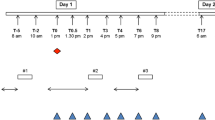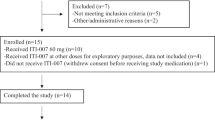Abstract
Rationale
JNJ-37822681 is a highly selective, fast dissociating dopamine D2-receptor antagonist being developed for the treatment of schizophrenia. A single dose [11C]raclopride positron emission tomography (PET) imaging study had yielded an estimated clinical dose range. Receptor occupancy at steady state was explored to test the validity of the single-dose estimates during chronic treatment.
Objectives
The aims of this study are to characterize single and multiple dose pharmacokinetics and obtain striatal D2-receptor occupancies to predict doses for efficacy studies and assess the safety and tolerability of JNJ-37822681.
Methods
An open-label single- and multiple-dose study with 10 mg JNJ-37822681 (twice daily for 13 doses) was performed in 12 healthy men. Twenty [11C]raclopride PET scans (up to 60 h after the last dose) from 11 subjects were used to estimate D2-receptor occupancy. A direct effect O max model was applied to explore the relationship between JNJ-37822681 plasma concentration and striatal D2-receptor occupancy.
Results
Steady state was reached after 4–5 days of twice daily dosing. JNJ-37822681 plasma concentrations of 3.17 to 63.0 ng/mL resulted in D2 occupancies of 0 % to 62 %. The concentration leading to 50 % occupancy was 18.5 ng/mL (coefficient of variation 3.9 %) after single dose and 26.0 ng/mL (8.2 %) at steady state. JNJ-37822681 was well tolerated.
Conclusions
Receptor occupancy after single dose and at steady state differed for JNJ-37822681 and the robustness of the estimates at steady state will be tested in phase 2 studies. Dose predictions indicated that 10, 20, and 30 mg JNJ-37822681 twice daily could be suitable for these studies.




Similar content being viewed by others
References
Abanades S, van der Aart J, Barletta JAR, Marzano C, Searle GE, Salinas CA, Ahmad JJ, Reiley RR, Pampols-Maso S, Zamuner S, Cunningham VJ, Rabiner EA, Laruelle MA, Gunn RN (2011) Prediction of repeat-dose occupancy from single-dose data: characterisation of the relationship between plasma pharmacokinetics and brain target occupancy. J Cereb Blood Flow Metab 31:944–952
Agarwal V, Kommaddi RP, Valli K, Ryder D, Hyde TM, Kleinman JE, Strobel HW, Ravindranath V (2008) Drug metabolism in human brain: high levels of cytochrome P4503A43 in brain and metabolism of anti-anxiety drug alprazolam to its active metabolite. PLoS One 3:e2337
Barnes TRE (1989) A rating scale for drug-induced akathisia. Br J Psychiatry 154:672–676
Brix G, Zaers J, Adam LE, Bellemann ME, Ostertag H, Trojan H, Haberkorn U, Doll J, Oberdorfer F, Lorenz WJ (1997) Performance evaluation of a whole-body PET scanner using the NEMA protocol. National Electrical Manufacturers Association. J Nucl Med 38:1614–1623
Collins DL, Zijdenbos AP, Kollokian V, Sled JG, Kabani NJ, Holmes CJ, Evans AC (1998) Design and construction of a realistic digital brain phantom. IEEE Trans Med Imaging 17:463–468
Cunningham VJ, Gunn RN, Matthews JC (2004) Quantification in positron emission tomography for research in pharmacology and drug development. Nucl Med Commun 25:643–646
Genz A (1992) Numerical computation of multivariate normal probabilities. J Comput Graph Stat 1:141–149
Ghosh C, Marchi N, Desai NK, Puvenna V, Hossain M, Gonzalez-Martinez J, Alexopoulos AV, Janigro D (2011) Cellular localization and functional significance of CYP3A4 in the human epileptic brain. Epilepsia 52:562–571
Gibaldi M, Perrier D (1982) Equation (3.69). In: Gibaldi M, Perrier D (eds) Pharmacokinetics, 2nd edn. Marcel Dekker, New York and Basel, p 132
Ginovart N, Wilson AA, Hussey D, Houle S, Kapur S (2009) D2-receptor upregulation is dependent upon temporal course of D2-occupancy: a longitudinal [11C]-raclopride PET study in cats. Neuropsychopharmacology 34:662–671
Kapur S, Seeman P (2001) Does fast dissociation from the dopamine D2 receptor explain the action of atypical antipsychotics? A new hypothesis. Am J Psychiatry 158:360–369
Kapur S, Remington G, Zipursky RB, Wilson AA, Houle S (1995) The D2 dopamine receptor occupancy of risperidone and its relationship to extrapyramidal symptoms: a PET study. Life Sci 57:L103–L107
Kapur S, Zipursky RB, Remington G, Jones C, DaSilva J, Wilson AA, Houle S (1998) 5-HT2 and D2 receptor occupancy of olanzapine in schizophrenia: a PET investigation. Am J Psychiatry 155:921–928
Kapur S, Zipursky RB, Remington G (1999) Clinical and theoretical implications of 5-HT2 and D2 receptor occupancy of clozapine, risperidone, and olanzapine in schizophrenia. Am J Psychiatry 156:286–293
Kapur S, Zipursky R, Jones C, Remington G, Houle S (2000) Relationship between dopamine D2 occupancy, clinical response, and side effects: a double blind PET study of first-episode schizophrenia. Am J Psychiatry 157:514–520
Kim E, Howes OD, Kim BH, Yu KS, Jeong JM, Lee JS, Kim SJ, Jang IJ, Park JS, Kim YG, Shin SG, Turkheimer FE, Kapur S, Kwon JS (2011) The use of healthy volunteers instead of patients to inform drug dosing studies: a [(11)C]raclopride PET study. Psychopharmacol (Berl) 217:515–523
Lammertsma AA, Hume SP (1996) Simplified reference tissue model for PET receptor studies. Neuroimage 4:153–158
Langlois X, Megens A, Lavreysen H, Atack J, Cik M, Te Riele P, Peeters L, Wouters R, Vermeire J, Hendrickx H, Macdonald G, De Bruyn M (2012) Pharmacology of JNJ-37822681, a specific and fast-dissociating D2 antagonist for the treatment of schizophrenia. J Pharmacol Exp Ther 342(1):91–105
Leysen JE, Janssen PMF, Heylen L, Van Gompet P, Lesage AS, Megens AAHP, Schotte A (1998) Receptor interactions of new antipsychotics: relation to pharmacodynamic and clinical effects. Int J Psychiatr Clin Pract 2:S3–S17
Lim KS, Kwon JS, Jang IJ, Jeong JM, Lee JS, Kim HW, Kang WJ, Kim JR, Cho JY, Kim E, Yoo SY, Shin SG, Yu KS (2007) Modeling of brain D2 receptor occupancy-plasma concentration relationships with a novel antipsychotic, YKP1358, using serial PET scans in healthy volunteers. Clin Pharmacol Ther 81:252–258
Nyberg S, Farde L, Eriksson L, Halldin C, Eriksson B (1993) 5-HT2 and D2 dopamine receptor occupancy in the living human brain. A PET study with risperidone. Psychopharmacology (Berl) 110:265–272
Nyberg S, Farde L, Halldin C (1997) A PET study of 5-HT2 and D2 dopamine receptor occupancy induced by olanzapine in healthy subjects. Neuropsychopharmacology 16:1–7
Nyberg S, Eriksson B, Oxenstierna G, Halldin C, Farde L (1999) Suggested minimal effective dose of risperidone based on PET-measured D2 and 5-HT2A receptor occupancy in schizophrenic patients. Am J Psychiatry 156:869–875
Remington G, Kapur S, Zipursky R (1998) The relationship between risperidone plasma levels and dopamine D2 occupancy: a positron emission tomographic study. J Clin Psychopharmacol 18:82–83
Samaha AN, Seeman P, Stewart J, Rajabi H, Kapur S (2007) “Breakthrough” dopamine supersensitivity during ongoing antipsychotic treatment leads to treatment failure over time. J Neurosci 27:2979–2986
Schmidt ME, Kent JM, Daly E, Janssens L, Van Osselaer N, Hüsken G, Anghelescu I-O, Van Nueten L (2012) A double-blind, randomized, placebo controlled study with JNJ-37822681, a novel, highly selective, fast dissociating D2 receptor antagonist, in the treatment of acute exacerbations of schizophrenia. Eur Neurophsychopharmacol (in press)
Seeman P (2002) Atypical antipsychotics: mechanism of action. Can J Psychiatry 47:27–38
Seeman P (2006) Targeting the dopamine D2 receptor in schizophrenia. Expert Opin Ther Targets 10:515–531
Silvestri S, Seeman MV, Negrete JC, Houle S, Shammi CM, Remington GJ, Kapur S, Zipursky RB, Wilson AA, Christensen BK, Seeman P (2000) Increased dopamine D2 receptor binding after long-term treatment with antipsychotics in humans: a clinical PET study. Psychopharmacology (Berl) 152:174–180
Simpson GM, Angus JWS (1970) A rating scale for extrapyramidal side effects. Acta Psychiatr Scand 212:11–19
Tauscher J, Jones C, Remington G, Zipursky RB, Kapur S (2002) Significant dissociation of brain and plasma kinetics with antipsychotics. Mol Psychiatry 7:317–321
Te Beek ET, Moerland M, de Boer P, van Nueten L, de Kam ML, Burggraaf J, Cohen AF, van Gerven JM (2011) Pharmacokinetics and central nervous system effects of the novel dopamine D2 receptor antagonist JNJ-37822681. J Psychopharmacol (in press)
Te Beek ET, de Boer P, Moerland M, Schmidt ME, Hoetjes NJ, Windhorst AD, Van Berkel B, Cohen AF, van Gerven JM, Lammertsma AA (2012) In vivo quantification of striatal dopamine D2 receptor occupancy by JNJ-37822681 using [11C]raclopride and positron emission tomography. J Psychopharmacol (in press)
Tournier N, Valette H, Peyronneau MA, Saba W, Goutal S, Kuhnast B, Dollé F, Scherrmann JM, Cisternino S, Bottlaender M (2011) Transport of selected PET radiotracers by human P-glycoprotein (ABCB1) and breast cancer resistance protein (ABCG2): an in vitro screening. J Nucl Med 52:415–423
Tzourio-Mazoyer N, Landeau B, Papathanassiou D, Crivello F, Etard O, Delcroix N, Mazoyer B, Joliot M (2002) Automated anatomical labeling of activations in SPM using a macroscopic anatomical parcellation of the MNI MRI single-subject brain. Neuroimage 15:273–289
Vernaleken I, Fellows C, Janouschek H, Bröcheler A, Veselinovic T, Landvogt C, Boy C, Buchholz HG, Spreckelmeyer K, Bartenstein P, Cumming P, Hiemke C, Rösch F, Schäfer W, Wong DF, Gründer G (2008) Striatal and extrastriatal D2/D3-receptor-binding properties of ziprasidone: a positron emission tomography study with [18F]fallypride and [11C]raclopride (D2/D3-receptor occupancy of ziprasidone). J Clin Psychopharmacol 28:608–617
Wu Y, Carson RE (2002) Noise reduction in the simplified reference tissue model for neuroreceptor functional imaging. J Cereb Blood Flow Metab 22:1440–1452
Acknowledgments
The authors are grateful to Marc de Meulder for the determination of plasma concentrations, to Terry Brown from Abiant, Inc., Chicago, IL, for the skillful analysis of all the imaging data, and to Sandra Boom (Pharma-Plus, The Netherlands) for her assistance in the preparation of this manuscript. Special thanks go to Thijs van Iersel (Xendo Drug Development, now QPS, Groningen, The Netherlands) and Joop van Gerven (Centre for Human Drug Research, Leiden, The Netherlands) for the medical supervision of the studies.
Conflicts of interest
This work was funded by Janssen Research and Development, a Johnson & Johnson company. Mark Schmidt, Peter de Boer, Martine Neyens, Stefaan Rossenu, Demiana William Faltaos, and Erik Mannaert were full-time employees of Janssen Research and Development at the time the work was performed; Mark Schmidt, Peter de Boer, Martine Neyens, and Erik Mannaert are still full-time employees. Abiant, Inc. (Randoph Andrews) was paid for the services conducted for this investigation by Janssen Research and Development. Demiana William Faltaos and Stefaan Rossenu do not have any financial ties to Johnson & Johnson.
Author information
Authors and Affiliations
Corresponding author
Additional information
Part of this work was presented at the 22nd Congress of the European College of Neuropsychopharmacology (ECNP), Istanbul, Turkey (September 12–16, 2009).
Rights and permissions
About this article
Cite this article
Schmidt, M.E., de Boer, P., Andrews, R. et al. D2-receptor occupancy measurement of JNJ-37822681, a novel fast off-rate D2-receptor antagonist, in healthy subjects using positron emission tomography: single dose versus steady state and dose selection. Psychopharmacology 224, 549–557 (2012). https://doi.org/10.1007/s00213-012-2782-1
Received:
Accepted:
Published:
Issue Date:
DOI: https://doi.org/10.1007/s00213-012-2782-1




